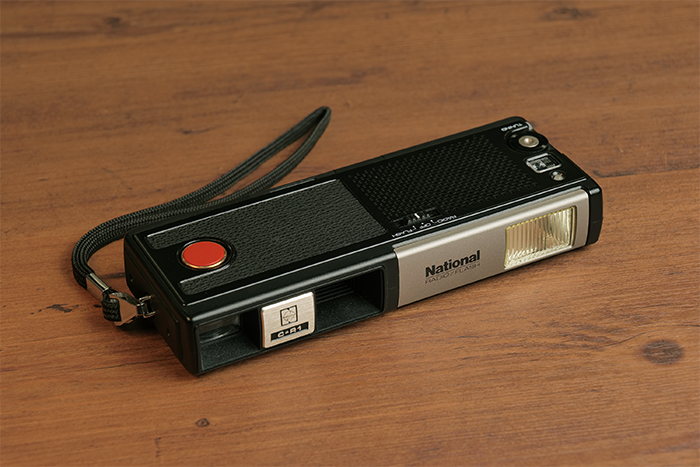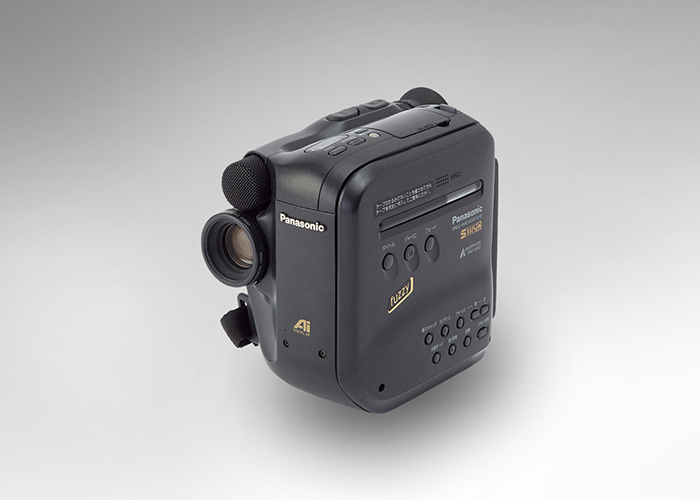 Chapter 1 : Roots
Chapter 1 : Roots
LUMIX’s actual history doesn’t date back 20 years?
LUMIX does have a 20-year history, but the history of our digital cameras is not 20 years. The underlying technology behind it has actually been around for a long time before then.
In this chapter, we will be going back in time before the year 2001 when LUMIX was established and find out how the company’s DNA that has been passed down since its founding was inherited by LUMIX.
Section 1: Was there such a camera before LUMIX?
The era traces back to the 1970s. At the time in Japan, there was a huge trend in personal travel and sports partly due to the impact of the Osaka Expo and the Sapporo Winter Olympics.
Q For example, this was released in 1978 but do you know what it is? The hint is a camera that integrated 〇〇 and ●●.

The answer is a radio camera with an integrated radio and camera.
That’s very unique. How did this idea come about? At the time, radios were a part of entertainment that were essential in daily life, and by integrating it with a camera, which was an item that you couldn’t forget to bring when going on a trip, it may have been a product that made recreation more enjoyable and comfortable.
In the LUMIX models that we are developing now, it has become normal to be able to shoot both videos and photos. This radio camera may have been a precursor to the concept of a “hybrid”.
Section 2: LUMIX already had these necessary elements!
So, what kind of technology existed before LUMIX? First of all, what about the optical technology required for a camera?
Panasonic's optical technology has a surprisingly long history. Panasonic originally excelled at precision processing in the manufacture of VHS video ferrite heads that were popular during the 1980s, as well as optical pickups for CDs and DVDs that were at the forefront of the subsequent era, and also produced lenses supplied to Panasonic camcorders and other companies. Particularly with aspherical lenses, Panasonic boasts top-class technology and 50 years of history. Even today, the lenses are manufactured in-house from consumer to professional video equipment.

Q What was Panasonic's strength when starting to manufacture digital cameras?
Panasonic’s strength was in their digital technologies such as image sensors and image processing engines. In the case of digital cameras, the sensor is responsible for the film and the engine is responsible for the picture-making, and they play an important role in controlling the depiction of the subject. This image-making technology that film manufacturers competed fiercely with each other for during the era of silver halide cameras could not be achieved overnight. However, we have been developing video cameras and professional video equipment for a long time, and we have a huge accumulation of image processing technology that was cultivated by being familiar with the "optimizing technology" of each lens, sensor and engine. Needless to say, Panasonic’s video camera technology that has captured powerful images and delivered them to the entire world as the official equipment for the Olympic Games for many years was later utilized in the development of LUMIX, which has strengths in both video and still images.
Section 3: Panasonic made the “image stabilizer” a common function
Today, image stabilization has become common, but our engineers were the first to invent this function in the world. Have you ever wondered why videos shot on your own were always blurry even though the images that you see on TV or movie theaters on a daily basis weren’t? Many of you may remember that initially, when home video cameras started to become widespread, there were many people who felt sick while playing a video. We were quick to pay attention to this problem and started developing the image stabilizer function. In 1988, Panasonic released the world’s first* video camera equipped with an optical image stabilizer function in the North American market.
* As a consumer video camera equipped with optical image stabilization

During the late 1980s in Japan, the reduction in size and weight of home video cameras was accelerated, and small passport-sized video cameras were a big hit. On the other hand, as the reduction in weight progressed, there was the disadvantage that hand-shake was likely to occur. So, we attempted to develop a technology to suppress hand-shake blurring while keeping the video camera compact and decided to introduce the image stabilization function as a last resort. Because the size of the optical system used for video cameras in the North American market was too big, we did our best to develop a new electronic image stabilizer. This function was equipped onto the epoch-making product called Brenby (Japanese abbreviation of "non-blur movie"), which was released in 1990. Due to the effects of the “Brenby dance”, which consisted of unique movements in the TV commercial, the Brenby instantly took the world by storm.

Image stabilization has now become a basic function of videos and cameras, but you can see how big the wave of a change that we created was. This image stabilization was also the foundation for the innovative technology of LUMIX.
Section 4: The first movement of the digital camera revolution begins
In the early days of digital cameras, our engineers witnessed the advent of digital cameras with LCD monitors that let you check the captured images on the spot, and we’re convinced that “this would change the times, and that digital cameras were next!” However, this passion did not bear fruit immediately, and it was not until several years later when the entire company united to enter the digital camera business.
Continues to chapter 2







